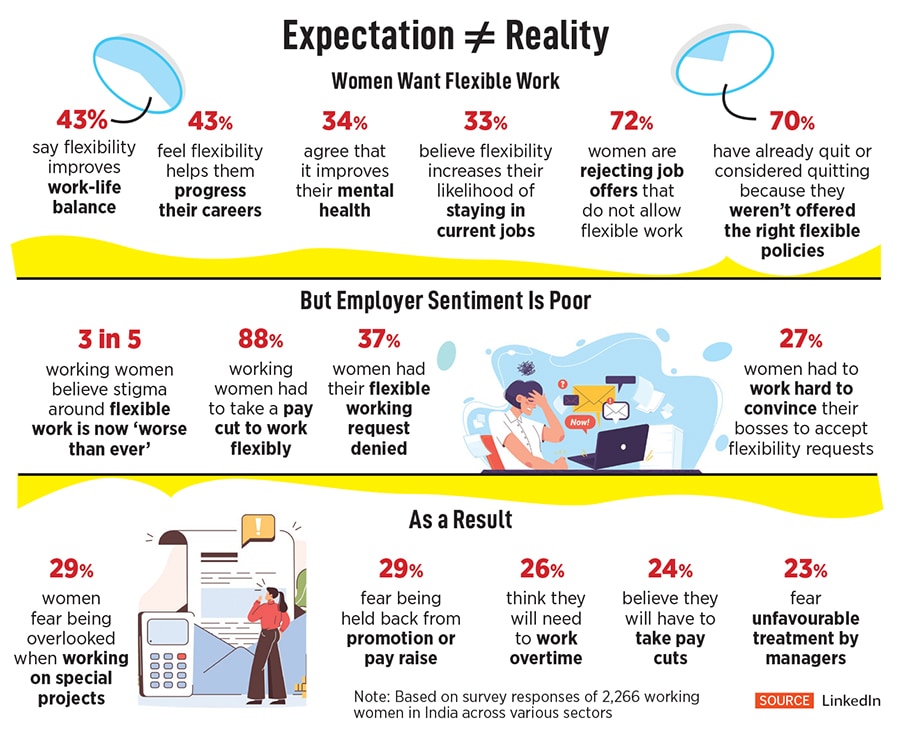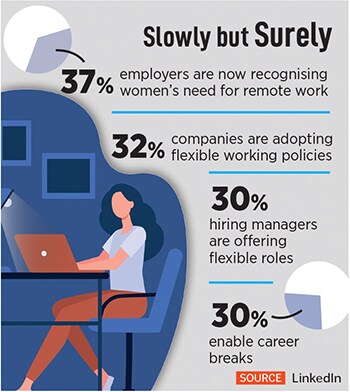
The TCS annual report shows women continue to pay a price for flexibility
High attrition of women in the IT industry says a lot about the lingering ghost of gender roles and lack of flexible policies. Companies can, and must, do better
 The IT sector has done well in terms of hiring women, if you look at the absolute numbers.
Image: Priyanka Parashar/Mint via Getty Images
The IT sector has done well in terms of hiring women, if you look at the absolute numbers.
Image: Priyanka Parashar/Mint via Getty Images
On June 6, India’s largest tech company, Tata Consultancy Services (TCS), said in its annual report that the attrition of women in its 600,000-strong workforce has been higher than men. Chief Human Resources Officer Milind Lakkad called this “unusual”, given that attrition rates of women have been lower or similar to that of men. “Intuitively, I would think working from home during the pandemic reset the domestic arrangements for some women, keeping them from returning to office after everything normalised,” he said in the report, which did not receive the exact attrition numbers on the basis of gender.
Women occupy 23 percent leadership positions at TCS and make up 38 percent of the company’s net hire this year. They form 35.7 percent of the workforce at TCS, falling from 36.2 percent in early 2020. Interestingly, in the case of competitor Infosys, which offers a more flexible, hybrid work policy, the proportion of women has gone up from 37.8 percent in early 2020 to 39.6 percent today. Higher attrition among women in FY23 is a setback for TCS in their efforts to promote gender diversity and inclusion, said Lakkad.
Attrition has been high across sectors despite hiring slowdown over the last three quarters, but the issue is amplified in the tech sector due to the volume of white collar talent and women in the workforce, says Kamal Karanth, co-founder of staffing firm Xpheno. He explains that the workforce in tech is comparatively more mobile and on the move in comparison to other sectors. “The IT industry still reports some of the highest attrition rates compared to other sectors. Therefore, while the trend of rising attrition is not specific to the IT industry, it definitely is higher in comparison to other sectors,” he says. According to World Bank statistics, the labour force participation of women as of 2022 has been stagnant at 23 percent since the pandemic.
The IT sector has done well in terms of hiring women, if you look at the absolute numbers. Data from Xpheno says the top five IT companies have added 1.5 lakh women professionals to the tech sector since 2020, which is a 44 percent growth. The total cohort of women in the IT sector stands at 5.36 lakh in March 2023, up from 3.74 lakh in the fiscal ending March 2020. “On a net headcount basis, TCS has recorded a 35 percent growth in women workforce since FY20. The other peers in this cohort have growth figures ranging from 44 percent to as high as 64 percent during this period,” says Karanth.
The problem, as it conventionally has been, is addressing the reasons why women drop out of the workforce as they rise up the career ladder, which coincides with other personal milestones like marriage, childbirth and caregiving responsibilities. In the wake of the pandemic, it also becomes important to look at how the fabric of our work culture has changed, and how it affects women more than others.





 In its annual report, TCS said that it has a flexible work arrangement in place, which “provides necessary support and flexibility of young children, expectant women employees, and persons with disability”. For every company calling employees back to office, there is another offering remote and hybrid opportunities, says Karanth. “One-fifth of the current active white collar opportunities are full-time remote and hybrid openings.”
In its annual report, TCS said that it has a flexible work arrangement in place, which “provides necessary support and flexibility of young children, expectant women employees, and persons with disability”. For every company calling employees back to office, there is another offering remote and hybrid opportunities, says Karanth. “One-fifth of the current active white collar opportunities are full-time remote and hybrid openings.”



